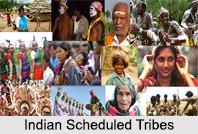 Indian Scheduled Tribes are the group of tribal communities and was given the name ‘Scheduled Tribes’ during the post-Independence period, under the rule of Indian Constitution. Since the Independence of India, the Scheduled Tribes were given Reservation status. India can proudly be called the largest tribal population in the world. The scheduled tribes in India constituted 8.2 percent of India’s population, according to 2011 census. In all, 698 scheduled tribes exist at present in India.
Indian Scheduled Tribes are the group of tribal communities and was given the name ‘Scheduled Tribes’ during the post-Independence period, under the rule of Indian Constitution. Since the Independence of India, the Scheduled Tribes were given Reservation status. India can proudly be called the largest tribal population in the world. The scheduled tribes in India constituted 8.2 percent of India’s population, according to 2011 census. In all, 698 scheduled tribes exist at present in India.The primary criteria adopted for delimiting Indian backward communities as Scheduled Tribes includes, traditional occupation of a definitive geographical area, characteristic culture that includes a whole range of tribal modes of life, i.e., language, customs, traditions, religious beliefs, arts and crafts, etc., archaic traits portraying occupational pattern, economy, etc., and lack of educational and economic development. The people in scheduled castes are essentially the lowest part of Hindu society.
Origin of Indian Scheduled Tribes
Scheduled Tribes in India, also referred to as Adivasis (original inhabitants), are spread all-over India. These various tribes resided in India long before the Aryans had arrived roughly during 1500 B.C.
Society of Indian Scheduled Tribes
More than 650 tribes that make up the Scheduled Tribes speak a multitude of languages. They are also religiously diverse, with some following animism, while others have adopted Hinduism, Islam or Christianity. The social traditions of most tribals make them stand out from the country’s mainstream Hindu population.
Revolutions of Indian Scheduled Tribes
The Indian scheduled tribes collectively owned property in keeping with their tradition. The colonial authorities had introduced a land administration where others infringed into traditional tribal lands on the grounds that such lands were ‘Terra Nullius’ meaning ‘no man’s land’. This led to a series of tribal revolts against British colonial rule. And these tribal revolts have been legendary in Indian history, referring to the Malpahariya uprising in 1772, the turbulence in Kutch in 1815 and 1832, the Bhil revolt of 1818, the uprising of the Mers in Rajputana in 1820, the rebellion of the Hos in Chota Nagpur in 1831, the uprising of the Khonds in Odisha in 1846 and the Santhal rebellion in Bihar in 1855. Heroes like Birsa Munda, Kanhu Santhal and Tantya Bhil stand out valiantly in the chronicles of Indian nationalism.
For more, visit the link below: